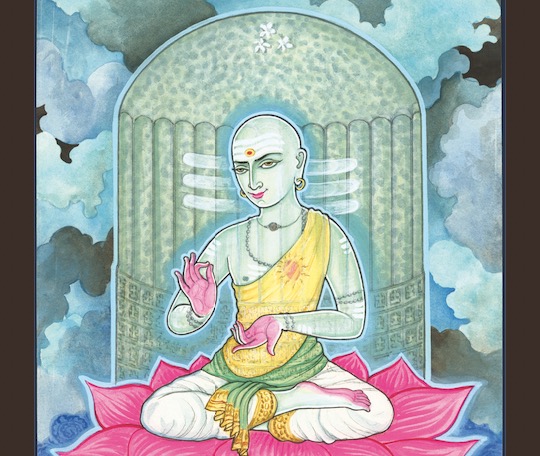FROM THE AGAMAS
“I AM THE SUPREME SELF”
______________________
An elucidation of the sadhaka’s inner identification with the Absolute
______________________
The following is a lucid translation from the Sarvajnanottara Agama, chapter 7, verses 1-16, describing the state of ultimate realization.
• • • • • • • • • • • • • • • • • • • • • •
IT IS BEYOND THE REACH OF MANTRAS. IT IS BEREFT OF ALL LIMITING factors. It is free from the three attributes (sattvika, rajasa and tamasa). It is not confined to a particular location and time. Free from the colors created by names and forms, It is the knower of all. All-pervasive and reveling in sublime calmness, It has Its active presence in each and every soul, and It is capable of simultaneously seeing and doing everything. It is bereft of the organs and instruments needed for the actions of ordinary beings, for It exists without any support for its presence. It is self-sustaining, extremely subtle, indestructible, ever-existent, incomparable, immeasurable and beyond all validation. The exalted Supreme Self is extolled to be of such transcendental characteristics.
The essential nature of awareness is to become one with the object that is deeply contemplated upon. If the sadhaka meditates continuously on a particular form, he assumes that form in due course. Whichever state of mind is meditated upon, he masters. The nature of being one, the nature of being many and all other such states of mind are reflected in him and his external creation. All the qualities of any form meditated upon become unfolded within him.
By meditating on the Supreme Lord, the sadhaka acquires a power so elevated that it gifts all fruits that may be desired by devotees. He becomes the bestower of all. Though he is one, he is seen in six different perspectives: bhuta-atma, antar-atma, tattva-atma, jiva-atma, mantra-atma and Parama-atma. Thus, the one and the same Self presents itself in many shades.
The bhutatma is the self which remains associated with a physical body, which is resultant of the five principal elements. The same self becomes the tattvatma when it identifies itself with the tattvas that constitute the subtle body. That same self becomes mantratma when it is in oneness with the form of mantra. It is called antaratma when it is associated with the four modes of sound—para, pashyanti, madhyama and vaikhari. When it is able to experience pleasure and pain with equality, is able to associate with the three attributes and also perseveres in worldly life, it is called jivatma. The same self becomes Paramatma when it remains freed from all these adjuncts.
The sadhaka who has elevated himself to the supreme state of Paramatma becomes inwardly established in eternity and endowed with the exalted qualities of Siva. He sees all forms and worlds within himself. The moment he slides down (the spine; the chakras) and holds the notion of duality, he creates for himself the chance of rebirth, even though he has been endowed with such supreme qualities. After birth, he would once again make efforts to elevate himself, such as offering services without expecting any reward and trying to discern the eternal from the transient. When the karmic effects of his previous actions are spent and he again sees pleasure, pain, praise and abuse with equanimity, the guru’s grace descends upon him.
When the proper time is reached to dissociate himself from the bondage of the tattvas, the supreme notion of non-duality unfolds itself. Even though the Supreme Self is only one, it appears to be manifold due to the mind, deluded by the notions of difference. Those who are not trained in the path of yoga and jnana keep themselves under the illusion that they are different from Siva. Being misled by erroneous knowledge, they recite hundreds of names to eulogize the Lord, who is only one and who is nameless.
When this highest knowledge dawns in the heart of the sadhaka, he begins to realize the qualities of his own supreme self, which are eternal and changeless.
A. MANIVEL
Realizations: The sadhaka, as pure awareness, becomes one with his object of contemplation
“I am indeed the Supreme Self. I am the indweller in all forms, Purusha, who is considered to be the source of all manifestations and evolutions. I am the Supreme and Absolute Reality. I am the one to be known by all and by all means. I am imperishable. All things which are perishable emerge only from me as differentiated extensions. I am completely free from the notion of existence and non-existence. I am One. I am Siva. I remain indestructible, even though I am pervading the perishable universe.”
Holding such views firmly, the enlightened sadhaka remains completely free from the effects of karmas, annihilated by his yogic disciplines. His knots of doubts are severed. Being established within his own self and unaffected by modifications of the mind, he contemplates his own eternal Self without interruption. Having dispelled all lingering mental impressions, being with contented heart, free from the three impurities—anava, karma and maya—and being firmly rooted in the unassailable notion of non-duality, the sadhaka should always meditate on his own self in total identity with the Absolute.
DR. S. P. SABHARATHNAM SIVACHARYAR, of the Adi Saiva priest lineage, is an expert in ancient Tamil and Sanskrit, specializing in the Vedas, Agamas and Shilpa Shastras. This excerpt is from his recent translation of the Sarvajnanottara Agama’s Vidya Pada.
